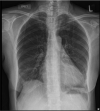Idiopathic recurrent serositis-Off the beaten track
- PMID: 34667614
- PMCID: PMC8506259
- DOI: 10.1002/rcr2.859
Idiopathic recurrent serositis-Off the beaten track
Abstract
A 63-year-old female presented with chest pain and fever, and was found to have recurrent pleuropericardial effusions. Extensive investigations including infection screen and serologies, autoimmune screen and pleural and pericardial biopsy revealed no secondary aetiologies. She was diagnosed with idiopathic recurrent serositis (IRS). Our patient developed rash to naproxen, so she was started on colchicine monotherapy and responded well clinically. A review of the literature demonstrated that pleuropericardial effusions are rare occurrences, with patients occasionally being perceived as a medical enigma. This case study recommends an approach to guide physicians in their diagnosis and management of patients with pleuropericardial syndrome. Our case had an inflammatory phenotype, either autoimmune or seronegative serositis of unclear aetiology, which was recurrent and required pharmacological treatment. While the treatment for IRS lies in combined therapy with Nonsteroidal Anti-Inflammatory Drugs (NSAIDs) and colchicine, monotherapy with colchicine was effective in the treatment and preventing recurrence in our unique case.
Keywords: effusion; pleuropericardial; recurrent; serositis.
© 2021 The Authors. Respirology Case Reports published by John Wiley & Sons Australia, Ltd on behalf of The Asian Pacific Society of Respirology.
Conflict of interest statement
None declared.
Figures
References
-
- Navaneethan S, Venkatesh S, Shrivastava R, Mehta J, Israel R. Recurrent pleural and pericardial effusions due to sarcoidosis. PLoS Med [Internet]. 2005. [cited 2021 Jan 30];2(3):e63. Available from: https://www.ncbi.nlm.nih.gov/pmc/articles/PMC1069661/ - PMC - PubMed
-
- Massaro M, Rigante D, Sicignano L, Verrecchia E, Vito F, Gasbarrini A, et al. Therapeutic management of idiopathic recurrent serositis: a retrospective study. Eur Rev Med Pharmacol Sci [Internet]. 2020. [cited 2021 Jan 30];6:3352–9. Available from: https://pubmed.ncbi.nlm.nih.gov/32271453/ - PubMed
-
- Janssen J, Maldonado F, Metintas M. What is the significance of non‐specific pleuritis? A trick question. Clin Respir J. 2018;12(9):2407–10. - PubMed
-
- Venekamp L, Velkeniers B, Noppen M. Does ‘idiopathic pleuritis’ exist? Natural history of non‐specific pleuritis diagnosed after thoracoscopy. Respiration. 2005;72(1):74–8. - PubMed
-
- Artom G, Koren‐Morag N, Spodick D, Brucato A, Guindo J, Bayes‐de‐Luna A, et al. Pretreatment with corticosteroids attenuates the efficacy of colchicine in preventing recurrent pericarditis: a multi‐centre all‐case analysis. Eur Heart J [Internet]. 2005. [cited 2021 Jul 30];26(7):723–7. Available from: https://pubmed.ncbi.nlm.nih.gov/15755753/ - PubMed
Publication types
LinkOut - more resources
Full Text Sources
Miscellaneous






